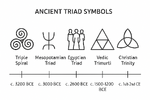Sindy-S.R
Jedi
Last year I came across this information:
In 2014, Graham Hancock posted images from Richard Cassaro's book "Written in Stone" on Twitter.
I remember that in an old Cass session, they had referred to this "connection" in ancient civilizations. I tried to search the forum without results. If any forum member remembers what it is, it would be interesting to relate it to Richard Cassaro's research.
My question would be whether this symbol is religious because it is the archetypal spiritual representation of opposites, or the graphic "logo" representation, for example, of an ancient forgotten technology, or perhaps a hyperdimensional technology.
Well, the possibilities are endless to speculate on what these symbols represent.
In 2016, there is an article by R. Cassaro on G. Hancock's website.
Who is Richar Cassaro:
I've searched YouTube for videos in English that explain the Godself Icon, but what I found was mostly mixed with Freemasonry. Personally, I'd prefer to see it from an archaeological perspective.
This video explains the idea of the Godself Icon well (it's in Italian).
In 2014, Graham Hancock posted images from Richard Cassaro's book "Written in Stone" on Twitter.
Pagan “God Self” Icon Found Worldwide Rewrites History, Reveals Lost Golden Age
By Richard Cassaro October 15, 2013 Category: Featured Articles
A new discovery (that I made many years ago, and that’s been officially published in my 2011 book “Written In Stone”) challenges―if not rewrites―ancient history by showing how the world’s first cultures mysteriously shared the same religious icon. From the Egyptians to the Assyrians, the pre-Incas to the Europeans, the icon is ubiquitous. Is it the lost symbol of a forgotten Golden Age religion that flourished globally in the remote past? How can it not be?
I remember that in an old Cass session, they had referred to this "connection" in ancient civilizations. I tried to search the forum without results. If any forum member remembers what it is, it would be interesting to relate it to Richard Cassaro's research.
My question would be whether this symbol is religious because it is the archetypal spiritual representation of opposites, or the graphic "logo" representation, for example, of an ancient forgotten technology, or perhaps a hyperdimensional technology.
Well, the possibilities are endless to speculate on what these symbols represent.
In 2016, there is an article by R. Cassaro on G. Hancock's website.
The Missing Link—Evidence of a Lost Civilization?
A major discovery set forth in my new book, The Missing Link, has the potential to upend everything we learned in school about ancient civilizations and ancient religions.
During the course of my research and travels to visit the ruins and artifacts of Antiquity, I repeatedly found variations of the same mysterious “icon” worldwide. The “GodSelf Icon”—the term I use to express my discovery—is a prominent feature in most ancient cultures, as the collage below shows:


Who is Richar Cassaro:
Richard Cassaro is a Madrid-based author, lecturer, filmmaker, and tour guide from New York City. His published books Written in Stone (2011), The Missing Link (2016), and Mayan Masonry (2018) offer rare insights into ancient megaliths, spirituality, mythology, magic, symbolism, secret societies, comparative religion and occult archaeology. Cassaro has discussed his work on the History Channel, and in documentary films like Magical Egypt 2. His articles have appeared in print journals and web media around the globe; and he has delivered well-received lectures about his findings in the UK, Italy, Peru, Egypt, Spain, Mexico, Cyprus, and the U.S. In his capacity as a field investigator, he hosts travel adventures to archaeological sites worldwide.
About Richard Cassaro - Graham Hancock Official Website
I've searched YouTube for videos in English that explain the Godself Icon, but what I found was mostly mixed with Freemasonry. Personally, I'd prefer to see it from an archaeological perspective.
This video explains the idea of the Godself Icon well (it's in Italian).



